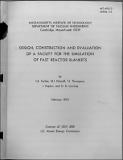| dc.contributor.author | Forbes, Ian Alexander | en_US |
| dc.contributor.author | Driscoll, Michael J. | en_US |
| dc.contributor.author | Thompson, Theos Jardin, 1918-1970 | en_US |
| dc.contributor.author | Kaplan, Irving, 1912- | en_US |
| dc.contributor.author | Manning, David D. | en_US |
| dc.contributor.other | Massachusetts Institute of Technology. Department of Nuclear Engineering | en_US |
| dc.contributor.other | U.S. Atomic Energy Commission | en_US |
| dc.date.accessioned | 2014-09-15T17:55:50Z | |
| dc.date.available | 2014-09-15T17:55:50Z | |
| dc.date.issued | 1970 | en_US |
| dc.identifier.uri | http://hdl.handle.net/1721.1/89562 | |
| dc.description | "February 1970." | en_US |
| dc.description | Statement of responsibility on title-page reads: I.A. Forbes, M.J. Driscoll, T.J. Thompson, I.Kaplan and D.D. Lanning | en_US |
| dc.description | Also issued as a Ph. D. thesis in the Dept. of Nuclear Engineering, MIT,1970 | en_US |
| dc.description | "MIT-4105-2." | en_US |
| dc.description | Bibliography: leaves 123-125 | en_US |
| dc.description.abstract | A facility has been designed and constructed at the MIT Reactor for the experimental investigation of typical LMFBR breeding blankets. A large converter assembly, consisting of a 20-cm-thick layer of graphite followed by a 17.5-cm-thick U0 2 fuel region, is used to convert thermal neutrons into fast neutrons to drive a blanket mockup. Operating at 55 watts, the converter generates blanket fluxes at an equivalent LMFBR core power of about 350 watts, with as little as one tenth of the blanket material required for a critical assembly. Calculations show that the converter leakage spectrum is a close approximation to the core leakage spectrum from reference LMFBR designs, and that the axial distribution of the neutron flux in the blanket assembly simulates that in the radial blanket of a large LMFBR when the effective height and width of the blanket assembly are correctly chosen. Testing of the completed facility with a blanket composed of 50 v/o iron and !
50 v/o borax showed that the lateral flux distributions were cosine-shaped, and that lateral spectral equilibrium was achieved in a large central volume of the blanket. Backscattering from concrete shielding surrounding the experiment was found to affect no more than the outer 30 cm of the blanket assembly, confirming the results of two-dimensional multigroup calculations. Measurements of the axial activity of gold and indium show good agreement with 16- group, S8 ANISN calculations. | en_US |
| dc.description.sponsorship | U.S. Atomic Energy Commission contract AT(30-1)4105 | en_US |
| dc.format.extent | 125 leaves | en_US |
| dc.publisher | Cambridge, Mass. : Massachusetts Institute of Technology, Dept. of Nuclear Engineering, [1970] | en_US |
| dc.relation.ispartofseries | MIT-4105-2 | en_US |
| dc.relation.ispartofseries | MITNE ; no. 110 | en_US |
| dc.relation.ispartofseries | AEC research and development report | en_US |
| dc.subject.lcc | TK9008.M41 N96 no.110 | en_US |
| dc.subject.lcsh | Breeder reactors | en_US |
| dc.subject.lcsh | Nuclear fuel elements | en_US |
| dc.subject.lcsh | Nuclear reactors -- Tables | en_US |
| dc.subject.lcsh | Fast reactors | en_US |
| dc.title | Design, construction and evaluation of a facility for the simulation of fast reactor blankets | en_US |
| dc.type | Technical Report | en_US |
| dc.identifier.oclc | 09825439 | en_US |
